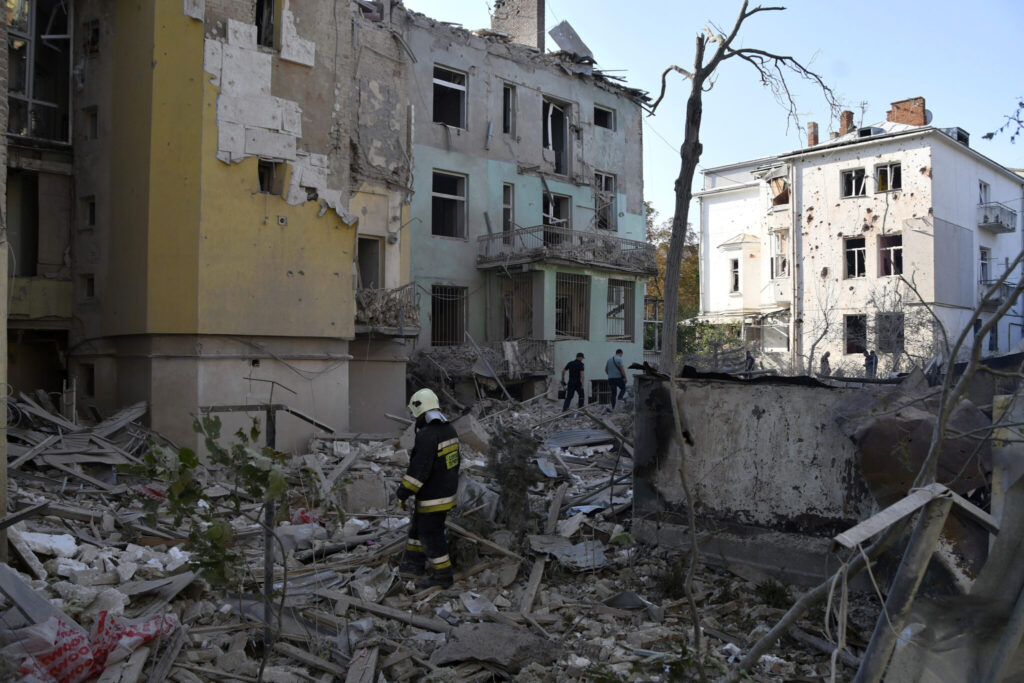NATO supports Ukraine strikes/ Ukraine long-range weapon debate/ NATO Ukraine military support/ Newslooks/ PRAGUE/ NATO’s military committee chair, Adm. Rob Bauer, expressed support for Ukraine’s right to strike inside Russia, emphasizing that defending against an attack doesn’t stop at a nation’s borders. While U.S. President Joe Biden weighs whether to allow Ukraine to use long-range American-made weapons, other NATO allies, including the Czech Republic, voiced fewer restrictions on Ukraine’s use of weapons. The debate highlights divisions among allies as Kyiv increases pressure for expanded military support ahead of winter.

NATO Chiefs Back Ukraine’s Right to Strike: Quick Looks
- Support for Ukraine’s Strikes: NATO Military Committee chair Adm. Rob Bauer supports Ukraine’s right to strike inside Russia for combat advantage.
- U.S. Hesitation: The Biden administration is still considering whether to allow Kyiv to use American-made long-range weapons for deeper strikes into Russia.
- NATO Divisions: While NATO leaders, including the Czech Republic, back Ukraine’s decision-making on weapon use, the U.S. maintains limits on long-range strikes.
- Storm Shadow Discussions: Biden met with British Prime Minister Keir Starmer, reportedly discussing whether to allow Ukraine to use British Storm Shadow missiles with U.S. components.
NATO Leaders Support Ukraine’s Deep Strikes on Russia, Amid US Hesitations
Deep Look
NATO’s top military officials, including Military Committee chair Adm. Rob Bauer, reaffirmed Ukraine’s right to strike deep inside Russian territory as a legitimate means of defense, even as U.S. policy restricts the use of long-range American-made weapons for such purposes. Speaking at the close of NATO’s annual military committee meeting in Prague, Bauer emphasized that “every nation that is attacked has the right to defend itself,” and that this defense is not limited by national borders.
Bauer’s remarks reflect growing support among some U.S. allies, including European nations like the Czech Republic, which advocate for fewer restrictions on the weapons supplied to Ukraine. Lt. Gen. Karel Řehka, chief of the General Staff of the Czech Armed Forces, echoed these sentiments, stating that “Ukrainians should decide themselves how to use” the weapons provided to them. This position underscores the divergent views within NATO regarding how Ukraine should be allowed to conduct its defense.
While many European nations have been vigorously supportive of Ukraine, reflecting their fears of being the next target of Russian aggression, the U.S. has been more cautious in its military aid. Current U.S. policy allows Ukraine to use American-provided weapons in cross-border strikes on Russian forces, but it stops short of permitting Kyiv to fire long-range missiles, such as the ATACMS, deep into Russian territory. The U.S. argues that Ukraine already has effective drone capabilities to conduct long-range strikes and should conserve its limited supply of ATACMS for strategic use.
Ukraine, facing the prospect of intensified Russian attacks as winter approaches, has been lobbying the U.S. to lift these restrictions. Kyiv argues that allowing deeper strikes into Russia would help weaken Russian logistics, fuel supplies, and ammunition depots—key to defending against ongoing assaults. “You want to weaken the enemy that attacks you…and also attack the archer that is…operating from Russia proper into Ukraine,” Bauer said, justifying Ukraine’s right to target Russian assets on its own soil.
The debate over long-range weapons has come into sharper focus following discussions between U.S. President Joe Biden and British Prime Minister Keir Starmer. The two leaders reportedly discussed the possibility of allowing Ukraine to use British Storm Shadow missiles for strikes inside Russia. While the Storm Shadow missile is British, it includes U.S.-made components, which means Biden’s approval may be necessary for their expanded use. U.S. officials have hinted that Biden may be open to the idea, but no formal decision has been announced.
Despite pressure from allies and Ukraine itself, U.S. policy on long-range strikes has so far remained unchanged. U.S. Gen. CQ Brown, chairman of the Joint Chiefs of Staff, who attended the NATO meeting, reiterated that the U.S. is committed to supporting Ukraine but within current policy constraints. “What we want to do is continue to make Ukraine successful with the capabilities that have been provided,” Brown told reporters, highlighting Ukraine’s success in building and deploying drones for long-range attacks.
Secretary of Defense Lloyd Austin has also echoed this sentiment, arguing that no single weapon system will determine Ukraine’s success in the war. “There is no silver bullet when it comes to things like this,” Austin said. He emphasized that while Ukraine may want more advanced long-range weapons, it has already demonstrated its ability to strike Russian targets using domestically-produced drones and other internally-developed systems.
The Biden administration’s cautious approach, however, contrasts with the more aggressive stance taken by some European NATO members, who believe Ukraine should be given full freedom to decide how to use the weapons they receive. Czech President Petr Pavel urged military leaders at the NATO meeting to be bold and clear in their recommendations, warning against soft or overly diplomatic language when addressing the serious threat posed by Russia.
As the war continues, Ukraine’s pleas for greater military support will likely intensify, especially with winter looming and the possibility of renewed Russian offensives. For now, the debate over long-range strikes reflects the delicate balancing act NATO must navigate in supporting Ukraine without escalating the conflict with Russia.







